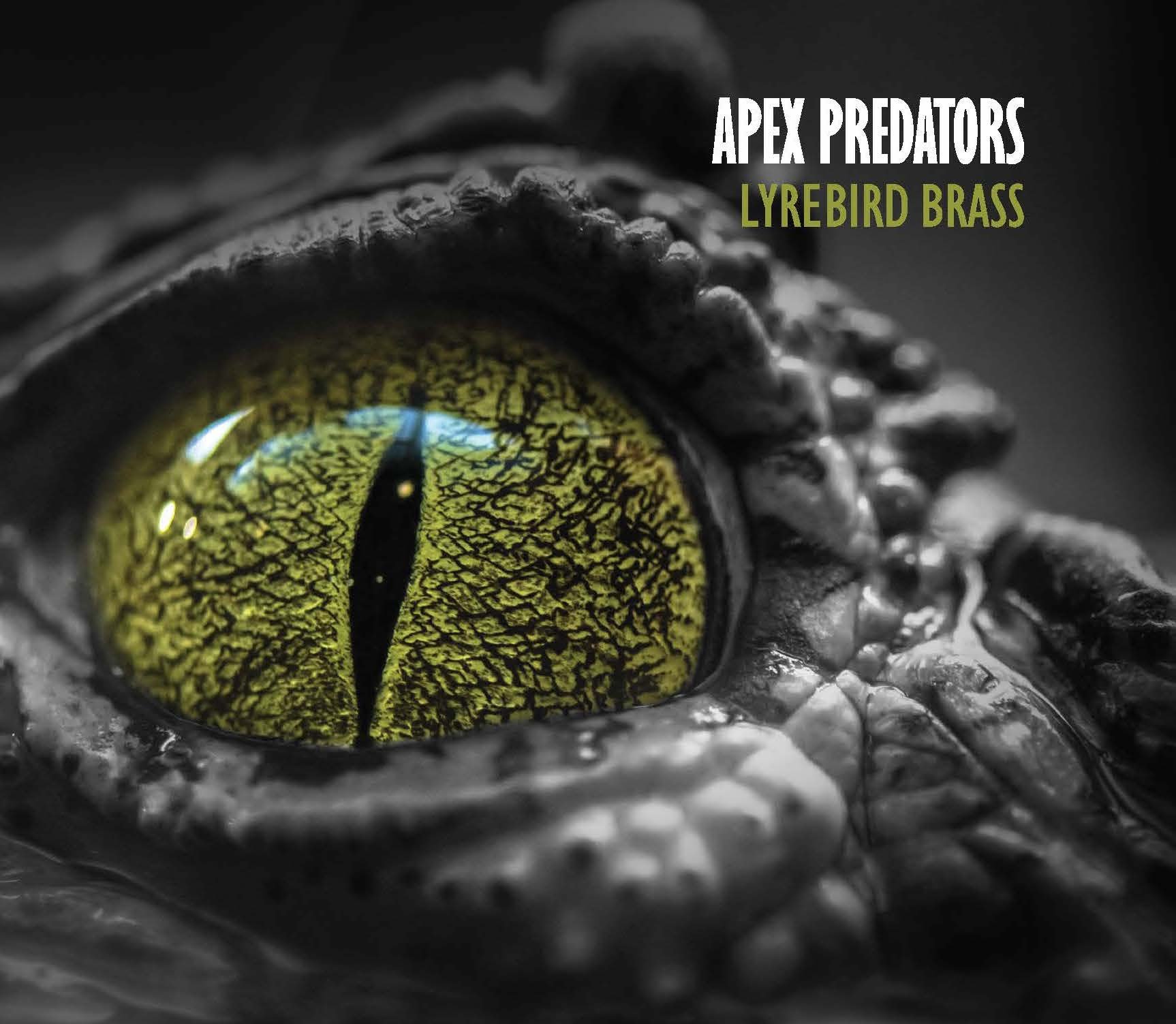TRACK INFORMATION
Melbourne Mosaic (2016), Andrew Batterham (b. 1968)
1. I. Shrine
2. II. Punt Road
3. III. Arcades
4. IV. Botanic Gardens
5. V. Spire
Divertimento (2013), Harry Sdraulig (b. 1992)
6. I. Overture
7. II. Intermezzo
8. III. Elegy
9. IV. Toccata
Solder (2019), Luke Styles (b. 1982)
10. I.
11. II.
12. III.
Neptune's Treasures (2021), Robert S. Cohen (b. 1945)
13. I. Descent of the Bathyscaphe
14. II. Reef Madness
15. III. Blobfish
16. IV. Breaking Hydrothermal: Neptune Rising
17. Apex Predators (2013), Catherine Likhuta (b. 1981)
ABOUT LYREBIRD BRASS
COPYRIGHT INFORMATION:
ABOUT THE PROJECT
Lyrebird Brass’s debut album takes its title from Catherine Likhuta’s Apex Predators. All of the works on the album are either by Australian composers, or pay tribute in some way to Australia and its inhabitants. The title is not only apt for featuring the premier recording of Apex Predators, but also because Australia - the home country of Lyrebird Brass - hosts many of the world’s deadliest creatures.
Lyrebird Brass is a collective of artists dedicated to performing the finest brass chamber music, with a mission to engage audiences through exceptional artistry and accessible programming. The members of Lyrebird Brass have each developed an international reputation performing in many of the world’s premier ensembles, bringing a unique musical flavour to the group. They aim to expand the brass repertoire through new commissions with an emphasis on Australian music and works by composers from underrepresented demographics. Paralleling their commissioning agenda, Lyrebird Brass also aims to reframe what it means to be a brass musician in the 21st century, and is the first professional Australian brass chamber ensemble to feature women as core members.
The group’s name pays homage to a unique songbird native to the ensemble’s hometown of Melbourne. Known for singing hours each day in a combination of mimicked noises and their own distinctive song, Lyrebirds are even able to vocalise multiple melodies simultaneously. The name is also a reference to Éditions de l’Oiseau-Lyre (Lyrebird Press), a part of Louise Hanson-Dyer’s legacy which has long benefited the Melbourne Conservatorium of Music where the ensemble currently teaches.
Joel Brennan & Rosie Turner, trumpet
Carla Blackwood, horn
Don Immel, trombone
Tim Buzbee, tuba
ABOUT THE COMPOSERS & COMPOSITIONS
Andrew Batterham’s quintet Melbourne Mosaic pays tribute to urban Australia, exploring five of Melbourne's most iconic places. Classically trained but experienced in the commercial and contemporary music industries, Batterham's original music is a blend of all of these. He has composed and arranged music for film, TV, radio, community groups, the corporate world, Latin and big bands, the education community, and the concert hall. His music has been performed by many of Australia’s leading performers, from jazz legend James Morrison to the Melbourne Symphony Orchestra. The first movement of Melbourne Mosaic captures the serenity and grandeur of the Shrine of Remembrance, built as a memorial to soldiers lost in the First World War. The opening bugle calls evoke a sense of loneliness and solemnity. The music rises to portray the participation of Victorians in wartime, before quietly ending with a wish that such an effort may never be needed again. Punt Road is one of Melbourne's major arterial roads, and is rarely anything other than organised chaos. In this movement the quintet mimics car horns before lurching into disjointed rhythms and funky beats that might be heard on the radios of the estimated 40,000 vehicles that use this road daily. Melbourne is renowned for its arcades, vibrant cafes, and unique boutiques. Arcades depicts the happy, unhurried browsing and shopping in one of Melbourne’s many laneways. The Royal Botanic Gardens are a peaceful, green oasis situated between central Melbourne and the Shrine of Remembrance. This movement depicts a relaxing stroll through the gardens on a warm day, with hints of the Shrine bugle calls intermingled. Spire references the State Theatre at the centre of Melbourne’s Arts Precinct, representing the beating cultural heart of the city. The distinctive spire that tops the Theatre is represented by the complex rhythmic figurations in the final movement, with the sounds of nearby Flinders Street Station making appearances throughout.
Harry Sdraulig is a prolific Sydney-based composer and educator. His work draws upon and extends the Western classical tradition in new ways, often juxtaposing passionate melodic lyricism with moments of intricate rhythmic interplay and drive, supported by an extended and rich harmonic palette which draws influences from classical, jazz, and occasionally popular musical styles. Sdraulig’s Divertimento is a suite of four contrasting miniatures, each designed to demonstrate the variety of colour, musical expression, and virtuosity of the brass quintet. The Overture is a lively movement featuring a variety of rapidly transforming musical thoughts and characters which, on closer inspection, bear much thematic resemblance to one another. An Intermezzo follows, serving as a somewhat phlegmatic interlude, occasionally interrupted by brief moments of unrest. The Elegy contains moments of positive reflection but remains otherwise a sombre and dark piece, traversing a variety of harmonic colours. The energetic and virtuosic final Toccata features rapid changes in metre and texture, with a reasonably free canon at its centre.
Luke Styles is a British/Australian composer performed regularly throughout the world. Career highlights include being the first Glyndebourne Young Composer in Residence, a 2-part ABC TV documentary on his work No Friend But The Mountains and his recent appointments as the British Council’s Musician In Residency for Brazil (2022). The title Solder refers to the fusible alloy used to join pieces of metal together in the manufacturing process of brass instruments. This functions as a metaphor for both the compositional process as well as the intricate ensemble work required to make a coherent brass quintet. The work explores the different timbral possibilities of changing pairings within the instrumentation, developing and re-forming over three movements to unlock various polyphonic and chordal sonorities. It is detailed chamber music with moments of fierce counterpoint and lyrical beauty. Although Solder can feel dramatic, and sets out to lead the listener down interlinking musical pathways, it is a work without programme or narrative. It goes to the heart of what brass music is all about. This work was Commissioned by the Canberra International Music Festival.
Robert S. Cohen has written music for chorus, orchestra, chamber ensemble, dance, and theatre and has been the recipient of numerous awards and commissions. His Do Not Enter for tuba and piano was performed by Lyrebird tubist Tim Buzbee as part of the Melbourne Digital Concert Hall series, and Alzheimer's Stories for soloists, chorus, and large ensemble has been performed numerous times throughout the world. Neptune's Treasures is a four movement musical exploration of the Great Barrier Reef. The first movement depicts the Descent of the Bathyscaphe into the depths of the ocean. A myriad of aquatic life living in and around the reef is encountered in Reef Madness. The third movement is a lament to what is thought by many to be one of the world's ugliest creatures, the Blobfish. The final movement - Breaking Hydrothermal: Neptune Rising is the composer's take on the process by which many believe life began, culminating with the rise from the deep of Neptune, the Roman god of the sea, who implores us to respect his kingdom.
Catherine Likhuta, PhD, is a Ukrainian/Australian composer whose music has been performed extensively around the world, including venues such as Carnegie Hall, Glyndebourne Opera House and the Midwest Clinic. She is a tw o-time winner of the International Horn Society Composition Contest, virtuoso division. Apex Predators are creatures at the top of the food chain, those with no natural predators. Likhuta brings these creatures to life cleverly using murky colours, extreme dynamics, bitey articulations, compact harmonies and various extended techniques, to evoke stalking, lurking, snarling, snapping and pouncing. The final trumpet duet brings to mind a chaotic struggle between a predator and its prey, swirling around until the natural conclusion is reached and the prey is silenced.
(Program notes by the composers and Lyrebird Brass)
Recorded around the 2020-2021 COVID-19 lockdowns at the Melbourne Conservatorium of Music, Ian Potter Southbank Centre, University of Melbourne, Australia.
Recorded, edited, and mastered by Jarrad Gilson, Oaklands Productions
Produced by Nicholas Williams and Elliott Gyger with assistance from Mads Sørensen and Tricia Teng.

